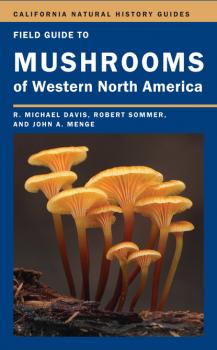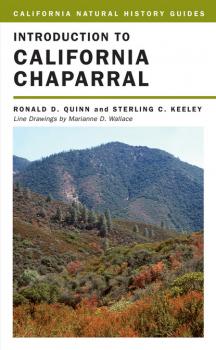California Natural History Guides
Скачать книги из серии California Natural History GuidesField Guide to Birds of the Northern California Coast
The Northern California coast–from Monterey County to the Oregon border–is home to some of the richest avian habitats on the North American continent. Field Guide to Birds of the Northern California Coast provides a comprehensive ecological overview of this extensive and diverse region. It features detailed discussions of the area's most common waterbirds, raptors, and landbirds and highlights the most productive birding sites in each Northern California coastal county.<BR /><BR /> Accessibly written and user-friendly, this guide contains nearly 250 species accounts that focus on seasonal rhythms and behavioral characteristics of each species. More than 130 color photographs and hand-drawn sketches depict the birds in context, and maps and occurrence charts indicate when readers might spot each species.
Field Guide to the Spiders of California and the Pacific Coast States
With over 40,000 described species, spiders have adapted to nearly every terrestrial environment across the globe. Over half of the world’s spider families live within the three contiguous Pacific Coast states—not surprising considering the wide variety of habitats, from mountain meadows and desert dunes to redwood forests and massive urban centers. This beautifully illustrated, accessible guide covers all of the families and many of the genera found along the Pacific Coast, including introduced species and common garden spiders. The author provides readers with tools for identifying many of the region’s spiders to family, and when possible, genus and species. He discusses taxonomy, distribution, and natural history as well as what is known of the habits of the spiders, the characters of families, and references to taxonomic revisions of the pertinent genera. Full-color plates for each family bring to life the incredible diversity of this ancient arachnid order.
Field Guide to Mushrooms of Western North America
California and the Western States are rich in abundant and diverse species of mushrooms. Amateur mushroom collectors and mycologists alike will find over 300 species of the region’s most common, distinctive, and ecologically important mushrooms profiled in this comprehensive field guide. It provides the most up-to-date science on the role of fungi in the natural world, methods to identify species, and locations of mushroom habitats. With excellent color illustrations showing top and side views of mushrooms of the Western States and a user-friendly text, it is informative but still light enough to be carried into the woods. When used to identify mushrooms, keys bring the reader to individual species, with a descriptive text providing cues for identifying additional species. Mushrooms common in urban landscapes are included, which is especially useful for the casual encounter with backyard fungi. The guide also provides a table of both old and new species names, and information on edibility and look-alikes, both dangerous and benign.<br /><br />A section on mushroom arts and crafts features mushroom photography, painting, philately, spore prints, dyes, and cultivation. The guide also offers a comprehensive list of resources including national field guides, general mushroom books and periodicals, club and society contact information, and web sites.<br /><br /><br /><br />· Primary descriptions and illustrations of 300 species of mushrooms plus text descriptions of many more.<br /><br />· Latest word in mushroom taxonomy and nomenclature. Clear discussion of DNA sequencing and new classifications. <br /><br />· Especially good coverage of southern California and Southwestern mushrooms often neglected in other field guides.<br /><br />
Field Guide to California Rivers
Award-winning author, naturalist, and conservationist Tim Palmer presents the world of California rivers in this practical and inspiring field guide. Loaded with tips on where to hike, fish, canoe, kayak, and raft, it offers an interpretive approach that reveals geology, plant and wild life, hydrologic processes, and other natural phenomena. Palmer reports on conservation with a perspective from decades of personal engagement. More than 150 streams are featured, 50 riparian species are illustrated, and 180 photos show the essence of California’s rivers. Palmer brings a natural history guide, a recreation guide, and an introduction to river ecology together in one illuminating volume; it belongs in every river lover’s book collection, boat, and backpack.
Natural History of San Francisco Bay
This complete primer on San Francisco Bay is a multifaceted exploration of an extraordinary, and remarkably resilient, body of water. Bustling with oil tankers, laced with pollutants, and crowded with forty-six cities, the bay is still home to healthy eelgrass beds, young Dungeness crabs and sharks, and millions of waterbirds. Written in an entertaining style for a wide audience, <i>Natural History of San Francisco Bay</i> delves into an array of topics including fish and wildlife, ocean and climate cycles, endangered and invasive species, and the path from industrialization to environmental restoration. More than sixty scientists, activists, and resource managers share their views and describe their work—tracing mercury through the aquatic ecosystem, finding ways to convert salt ponds back to tidal wetlands, anticipating the repercussions of climate change, and more. Fully illustrated and packed with stories, quotes, and facts, the guide also tells how San Francisco Bay sparked an environmental movement that now reaches across the country.
Trees and Shrubs of California
California's varied landscape is characterized by a spectacular abundance of plant life, including a magnificent variety of trees and shrubs. This is the first book to combine the trees and shrubs of California in one accessible field guide. <I>Trees and Shrubs of California </I>identifies and describes native California tree species and most common shrub species. The text is complemented by more than 200 beautiful line drawings, 300 range maps, and 40 color photographs.<br /><br />In their introduction, the authors discuss the dominant vegetation types, climates, principal landforms, and elevations of California's ecological regions. They explain the classification system and nomenclature used in the book, which includes both scientific and common plant names and is based on the 1993 edition of <I>The Jepson Manual. </I>The authors also provide a step-by-step explanation of how to use the dichotomous keys to identify plants and distinguish between trees and shrubs.<br /><br />This user-friendly field guide minimizes technical terms and includes a checklist, making it an invaluable resource on California's profuse vegetation.
Introduction to California Chaparral
The characteristic look of California Chaparral—a soft bluish-green blanket of vegetation gently covering the hills—is known to millions who have seen it as the backdrop in movies and television productions. This complex ecological community of plants and animals is not just a feature of the hills around Hollywood, but is a quintessential part of the entire California landscape. It is a highly resilient community adapted to life with recurring fires and droughts. Written for a wide audience, this concise, engaging, and beautifully illustrated book describes an ancient and exquisitely balanced environment home to wondrous organisms: Fire Beetles that mate only on burning branches, lizards that shoot blood from their eyes when threatened, Kangaroo Rats that never drink water, and seeds that germinate only after a fire, even if that means waiting in the soil for a 100 years or more. Useful both as a field guide and an introductory overview of the ecology of chaparral, it also provides a better understanding of how we might live in harmony, safety, and appreciation of this unique ecological community.<br /><br /><br /><br />* Identifies chaparral’s common plants, animals, birds, reptiles, amphibians, and insects <br /><br />* Features 79 color illustrations, 56 black-and-white photographs, and 3 maps<br /><br />* Examines the role of humans and fire in chaparral, covering the placement and design of homes, landscaping, and public policy
Field Guide to the Common Bees of California
This engaging and easy-to-use natural history guidebook provides a thorough overview of native and honey bee biology and offers tools for identifying the most common bees of California and the Western United States. Full-color illustrations introduce readers to more than 30 genera of native bees, noting each one's needs and habits and placing them in their wider context. The author highlights bees’ ties to our own lives, the food we eat, and the habitat we provide, and suggests ways to support bees in our own backyards.<br> <br> In addition to helping readers understand and distinguish among major groups of bees, this guide reveals how bees are an essential part of healthy ecosystem and how many plants, including important crop plants, depend on the pollination they provide. As growing evidence points to declining bee populations, this book offers critical information about the bond between plants and pollinators, and between humans and nature. Thoroughly researched and full of new insights into the ancient process of pollination,<i> Field Guide to the Common Bees of California; Including Bees of the Western United States</i> is invaluable for the window it opens onto the biodiversity, adaptive range, and complexity of invertebrate communities.<br>
Field Guide to Animal Tracks and Scat of California
Spotting an animal’s fresh footprints in the wild can conjure a world for the hiker: Why did the deer tracks disappear? Where did the cougar turn off the trail? What does it mean when two sets of footprints seem to coincide? This beautifully illustrated field guide, the first devoted to the tracks and signs of California animals—including birds, mammals, reptiles, amphibians, and invertebrates like spiders and beetles—blends meticulous science with field experience to provide an engaging companion for both armchair exploration and easy field identification. Filled with useful tools for the wildlife expert, and essential background and visual aids for the novice, including in-depth information about the ecology of each species, this book goes beyond basic recognition of types to interpret what animals leave behind as a way of «seeing» how they move through the world.









